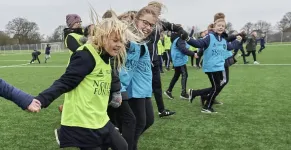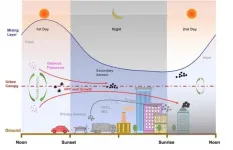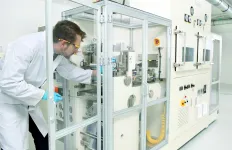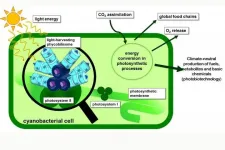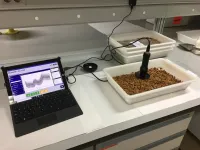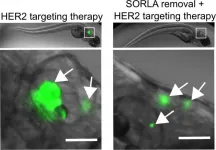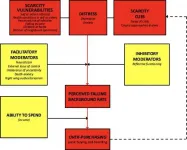(Press-News.org) Knowledge about health is a cornerstone in a child's development of physical and psychosocial health.
Since 2016, around 25,000 pupils in years 4-6 in 86 of Denmark's municipalities have taken part in the project "11 for Health in Denmark", an 11-week exercise and health education programme offered to all schools in a collaboration between the University of Southern Denmark and the Danish Football Association.
More than 3,000 of these pupils completed questionnaires before and after the programme aimed at determining their knowledge about health and understanding their experience of the 11-week programme.
An increase of 10 percentage points in health knowledge
The main article from this study, which has now been published in leading sports science journal the British Journal of Sports Medicine, confirms that the programme is meeting its key objectives:
"The participating children increased their knowledge about health in the areas of diet, exercise, hygiene and wellbeing to a greater extent than the control group, which followed the originally planned lessons in the 11 weeks between the questionnaires. There was a difference between the groups of more than 7 percentage points for both boys and girls, and in a number of key health areas the difference was more than 10 percentage points," says postdoc Malte Nejst Larsen, the article's lead author.
"The idea that children learn best if they can connect the learning to relevant activities is not new, but it's rare for such large studies to be carried out in real-world schools - and with such unambiguous results," he says.
Physical activity during coronavirus
The "11 for Health" concept was developed long before the coronavirus epidemic, but it has proven effective in relation to all the current challenges around health, fitness, physical activity, wellbeing and knowledge about hygiene.
The latest results show very clearly that it is possible to combine health learning with exercise that is fun, motivational and inclusive for all children - including those who have very little experience of sport. A good example is that the children doubled their knowledge about hand hygiene through the programme.
This was explained by the project's lead researcher Professor Peter Krustrup of the Department of Sports Science and Clinical Biomechanics at the University of Southern Denmark, who stresses that there was record-high participation in autumn 2020.
The researchers are also, therefore, delighted that the Nordea Foundation (Nordea-fonden), which has been supporting the project since 2018, has extended its support through to summer 2021. The project group is currently seeking funding for an ambitious expansion of the concept and a research study of the concept's long-term effects.
Both boys and girls like the project
The article also provides data on the children's opinion of the programme. These show very encouragingly that the girls rate the programme just as highly as the boys (4 on a scale of 1-5), despite the fact that the girls generally have considerably less experience of football than the boys.
Bent Clausen, Vice President of the Danish Football Association with a focus on amateur football, is delighted about this:
"It is great that '11 for Health' is able to have a broad reach and spark an interest in football in all children, both boys and girls, beginners and experienced players. After all, that is what football is really good at - including everyone no matter what their background. And with the school programme a natural next step, and an important aid for the associations, is getting new players and including them in the valuable communities within the football clubs."
INFORMATION:
About the study
Researchers from the University of Southern Denmark studied 3,117 participants in the "11 for Health in Denmark" project.
The participants were boys and girls in year 5.
The participants completed a questionnaire at the start of the study and again after 11 weeks.
The results show that:
"11 for Health in Denmark" improves health knowledge in 10-13-year-old Danish children by up to approx. 10 percentage points.
The teaching of "11 for Health in Denmark" is equally effective for girls and boys, and girls achieve the best outcomes for wellbeing.
Girls and boys rate the programme equally highly.
"11 for Health in Denmark" can play an important role in preventing diseases.
The "11 for Health in Denmark" project is financially supported by the Nordea Foundation (Nordena-fonden).
What are the prospects for "11 for Health"?
Politicians, school heads, teachers and educators can use this knowledge and the "11 for Health in Denmark" programme when implementing health teaching in middle schools.
The programme has the potential to motivate and engage more 10-13-year-old children, especially girls, in sports clubs after they have had a positive experience of football and physical activity.
The scaled-up programme is tailored for use in western countries to promote a combination of health education and motivational physical activity, with broad-spectrum improvements in health knowledge, wellbeing, cognitive function and physiological health profile.
In connection with the publication of the "11 for Health in Denmark" main article in the British Journal of Sports Medicine, the editor writes in a leader that the Danish version of the concept can usefully be extended to the entire western world.
New particle formation (NPF) is a major source of aerosol particles in the global atmosphere. In polluted megacities, such as Beijing, the role of new particle formation events and their contribution to haze formation through subsequent growth is still unclear.
To improve the understanding of the sources, meteorological conditions, and chemistry behind air pollution, the research teams led by Prof. Yele Sun with the Institute of Atmospheric Physics at the Chinese Academy of Sciences and Prof. Markku Kulmala with the University of Helsinki performed simultaneous measurements ...
Research on manufacturing battery cells is gaining momentum - and there is a strong need, considering the future demand for energy storage: For the year 2030, global production of rechargeable batteries will double from today's 750 gigawatt hours (GWh) per year to 1,500 GWh. A recently published review article in the magazine "Nature Energy" on cell production of various battery types suggests that the currently established lithium-ion batteries (LIB) dominate the market of rechargeable high-energy batteries in the coming years. Alternative battery technologies, ...
Large parts of today's Sahara Desert were green thousands of years ago. Prehistoric engravings of giraffes and crocodiles testify to this, as does a stone-age cave painting in the desert that even shows swimming humans. However, these illustrations only provide a rough picture of the living conditions. Recently, more detailed insights have been gained from sediment cores extracted from the Mediterranean Sea off the coast of Libya. An international research team examined these cores and discovered that the layers of the seafloor tell the story of major environmental changes in North Africa over ...
The biological process of photosynthesis is found at the beginning of nearly all food chains. It produces oxygen to breathe and provides the energetic foundation for using biotechnological processes to synthesize biofuels and chemical feedstock. Therefore, researchers are particularly interested in rapidly growing cyanobacteria. These organisms use light as an energy source and can carry out photosynthesis, similar to plants. However, the required photosynthetic protein complexes bind many nutrients. Vanessa Krauspe and Prof. Dr. Wolfgang Hess from the working group for Genetics & Experimental Bioinformatics of the Faculty of Biology of ...
Who hasn't at some point been chewing on an almond and tasted an unpleasant and unexpected aftertaste that has nothing to do with the taste we are used to from one of the most consumed nuts in the world? The culprit has a name: amygdalin, a diglucoside that, when in contact with enzymes present in saliva, breaks down into glucose, benzaldehyde (the cause of the bitter taste) and hydrogen cyanide.
To reduce this unpleasant 'surprise', the Farming Systems Engineering (AGR-128) and Food Technology (AGR-193) research groups at the University of Cordoba's School of Agricultural and Forestry Engineering, ...
SORLA is a protein trafficking receptor that has been mainly studied in neurons, but it also plays a role in cancer cells. Professor Johanna Ivaska's research group at Turku Bioscience observed that SORLA functionally contributes to the most reported therapy-resistant mechanism by which the cell-surface receptor HER3 counteracts HER2 targeting therapy in HER2-positive cancers. Removing SORLA from cancer cells sensitized anti-HER2 resistant breast cancer brain metastasis to targeted therapy.
HER2 protein is a strong driver of tumor growth. HER2 amplification occurs ...
High-intensity tropical cyclones have been moving closer to coasts over the past 40 years, potentially causing more destruction than before.
The trend of tropical cyclones - commonly known as hurricanes or typhoons - increasingly moving towards coasts over the past 40 years appears to be driven by a westward shift in their tracks, say the study's authors from Imperial College London.
While the underlying mechanisms are not clear, the team say it could be connected to changes in tropical atmospheric patterns possibly caused by climate change. The research is published today in Science.
Globally, 80 to 100 cyclones develop over tropical oceans each year, impacting regions in the Pacific, ...
New research by Mimi E. Lam (University of Bergen) just published in Humanities and Social Sciences Communications identifies and explores the impacts of salient viral or COVID-19 behavioural identities that are emerging.
"These emergent COVID-19 behavioural identities are being hijacked by existing social and political identities to politicize the pandemic and heighten racism, discrimination, and conflict," says Lam. She continues: "the COVID-19 pandemic reminds us that we are not immune to each other. To unite in our fight against the pandemic, it is important to recognize the basic dignity of all and value the human diversity currently dividing us."
"Only ...
Drawing on animal-foraging theory, a new model predicts psychological factors that may lead to panic buying during times of crisis. The model is largely supported by real-world data from the COVID-19 pandemic. Richard Bentall of the University of Sheffield, England, and colleagues presented these findings in the open-access journal PLOS ONE on January 27.
In the early stages of the pandemic, consumers in several countries around the world engaged in "panic buying" of household items, causing temporary shortages of toilet rolls and other products. Such behavior is typical during times of crisis, but few studies have examined the psychology of crisis-driven over-purchasing.
To better understand this phenomenon, Bentall and colleagues turned to animal-foraging ...
As one of the most experienced archaeologists studying California's Native Americans, Lynn Gamble(link is external) knew the Chumash Indians had been using shell beads as money for at least 800 years.
But an exhaustive review(link is external) of some of the shell bead record led the UC Santa Barbara professor emerita of anthropology to an astonishing conclusion: The hunter-gatherers centered on the Southcentral Coast of Santa Barbara were using highly worked shells as currency as long as 2,000 years ago.
"If the Chumash were using beads as money 2,000 years ago," Gamble said, "this changes our thinking of hunter-gatherers and sociopolitical and economic complexity. This may be the first example of the use of money anywhere in the ...
